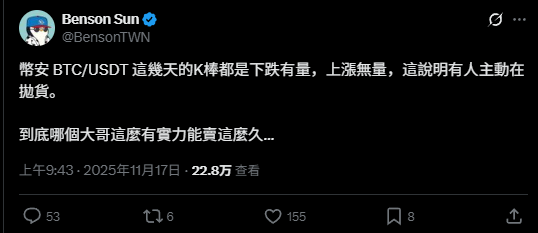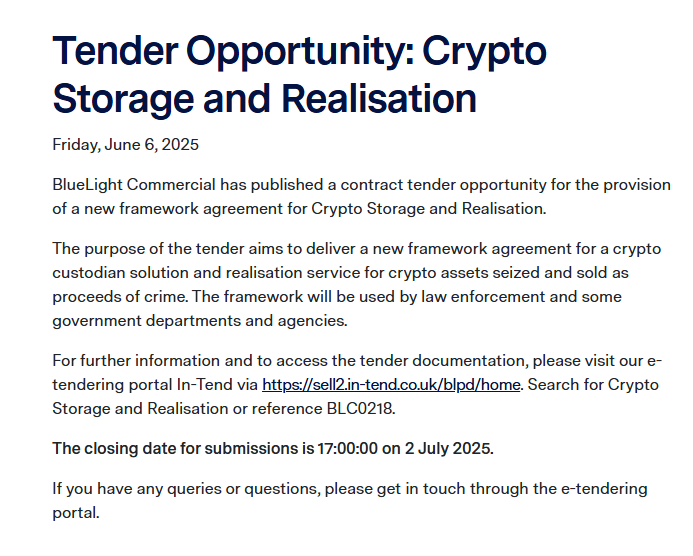Written by: Oliver, Mars Finance
"The recent K-lines show a decline with volume and an increase without volume, indicating that someone is actively dumping."

On November 18, this comment circulating on platform X accurately captured the common sentiment among traders recently. The market has fallen into a strange state of "suppression," where every rebound seems "weak," as if an invisible hand is continuously and mechanically selling off.
The market is haunted by the specter of "Mt. Gox," but they may have misidentified the "market crusher."
A recent in-depth report based on court documents from November reveals a more structural source of selling pressure that the market has overlooked: the UK government.
In the case of "Crypto Queen" Qian Zhimin, UK authorities have successfully seized and controlled over 61,000 bitcoins. Now, all evidence suggests that the UK government is actively preparing to "liquidate" this asset, motivated not by "value investment," but to fill its multi-billion-pound "fiscal gap."
In stark contrast to the "HODLers" creditors of Mt. Gox, a rational, profit-driven "national-level whale" holding 61,000 BTC is about to become a long-term market "resistance level."
Intent Confirmation: The UK is "tendering" for liquidation
Regarding the fate of these 61,000 BTC, the market once had "romantic" fantasies.
Industry groups and commentators have publicly called for the UK government to follow El Salvador's example and incorporate this batch of "digital gold" into its "national strategic reserves."
However, the UK Treasury has explicitly rejected this proposal, citing "concerns about volatility."
The UK government's intent is very clear: to sell.
They are not just talking. Reports reveal that the Home Office has issued a formal tender worth up to £40 million to £60 million through its commercial service agency, BlueLight Commercial.
The purpose of this tender is to seek the establishment of a "cryptocurrency storage and liquidation framework."

The wording of the tender is straightforward, seeking a "SaaS-based custody and trading service" to achieve the "realisation" of seized assets.
All speculation can end here. Liquidation is the only path being executed.
Motivation Analysis: A £5 billion "fiscal gap"
Why is the UK government so eager to sell?
The answer is simple: they need money.
Analysis indicates that the UK government is facing a massive "fiscal gap" of £5 billion to £20 billion. Chancellor Rachel Reeves is "closely monitoring" this "windfall."
These 61,000 bitcoins were valued at about £300 million when seized in 2018, but now their value has soared to approximately £5 billion to £5.5 billion.
This "windfall" has become a highly tempting direct source to fill the budget deficit.
More "subtly," the UK government seems to have found a legal path to "legally appropriate" this massive appreciation. The core controversy of the case lies in the fact that the UK Crown Prosecution Service (DPP) has proposed a "custom compensation plan" to the High Court.
This plan is likely to rule that the 128,000 Chinese victims are only entitled to recover their "original fiat currency losses from 2018" (about £640 million).
This means that the UK Treasury will legally "retain" the more than £4.5 billion "appreciation gains."
With such a strong "fiscal incentive," the UK government selling this batch of bitcoins at a high price in an orderly manner is a foregone conclusion.
Core Comparison: Why it is much scarier than "Mt. Gox"?
The current mainstream narrative in the market is that "the selling pressure from Mt. Gox has been digested." However, market analysts warn that equating the UK government's (UKGov) selling with Mt. Gox is completely erroneous.
The market dynamics of the two are entirely different:
1. Mt. Gox:
- Assets: Approximately 142,000 bitcoins.
- Recipients: Long-term creditors.
- Motivation: These creditors are "believers" who have undergone a decade-long legal struggle. They ultimately chose to be compensated in bitcoin (rather than yen). They are ideologically consistent "HODLers" (long-term holders).
- Market Impact (forecast): Low. Analysts generally expect that only a "small portion" of creditors will sell immediately. The market can easily absorb this "marginal" selling pressure.
2. UKGov (Qian Zhimin case):
- Assets: Approximately 61,000 bitcoins.
- Seller: UK government (Treasury / Home Office).
- Motivation: Fiscal need (to fill the budget gap).
- Market Impact (forecast): High (sustained). This constitutes pure, inorganic selling pressure.
The bitcoins from Mt. Gox are transferred from one "cold wallet" to another group of "cold wallets." In contrast, the UK government's bitcoins are transferred directly from a "cold wallet" to an "exchange hot wallet," with the sole purpose of "liquidating for fiat currency."
German Precedent: A "stress test" of 50,000 BTC
How will the UK government sell? They will not "foolishly" replicate the inefficient model of the US Marshals Service (USMS) from 2014-2015 with "public auctions."
Reports point to a closer, more likely template: the German government selling 50,000 bitcoins in 2024.
At that time, the German government adopted a more modern approach, selling the funds in batches through mainstream exchanges like Kraken and Coinbase, as well as over-the-counter (OTC) market makers.
The market impact was immediate. Reports indicated that this move caused "tremendous" and "violent" selling pressure in the short term, severely shaking the market.
However, in the end, the market successfully absorbed this supply.
The German precedent proves two things:
- The market has the capacity to digest a supply of 50,000 to 60,000 bitcoins.
- The digestion process will be extremely painful and accompanied by severe volatility.
Conclusion: Not a "flash crash," but a "pressure cap"
Now we can answer the question circulating on platform X: "Which big player has the strength to sell for so long?"
The answer is: the UK Treasury.
For the market, the most critical question—"Will it crash?"—has a clear answer:
It will not be a catastrophic "flash crash." The UK government's "liquidation framework" tender has already hinted that this is a professional, long-term (possibly lasting 3-4 years) controlled liquidation aimed at "maximizing fiat returns."
But it will be a "long-term resistance level."
The market must digest the fact that a major Western government (the UK) is about to become a rational, profit-driven large seller holding 61,000 bitcoins.
This "inorganic selling pressure" will act like a "cap," continuously suppressing the market's upward space over the coming years. With each rebound, traders will have to estimate: "How much will the UK government sell today?"—until all 61,000 bitcoins are absorbed by the market.
免责声明:本文章仅代表作者个人观点,不代表本平台的立场和观点。本文章仅供信息分享,不构成对任何人的任何投资建议。用户与作者之间的任何争议,与本平台无关。如网页中刊载的文章或图片涉及侵权,请提供相关的权利证明和身份证明发送邮件到support@aicoin.com,本平台相关工作人员将会进行核查。




